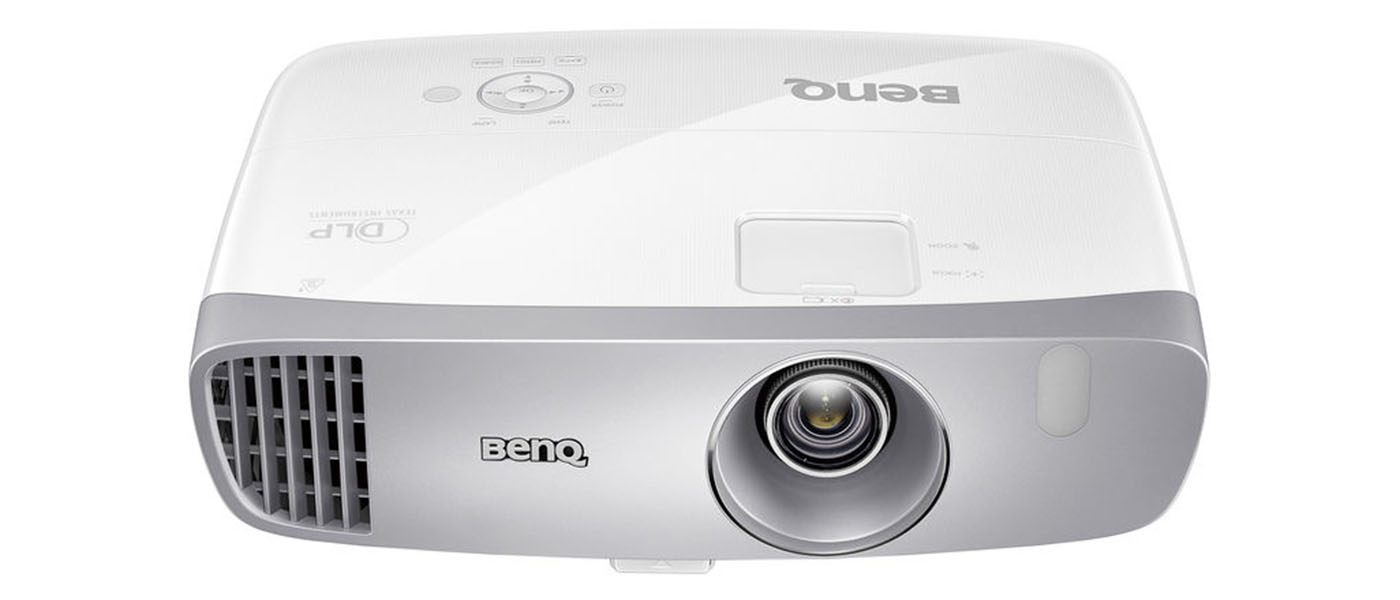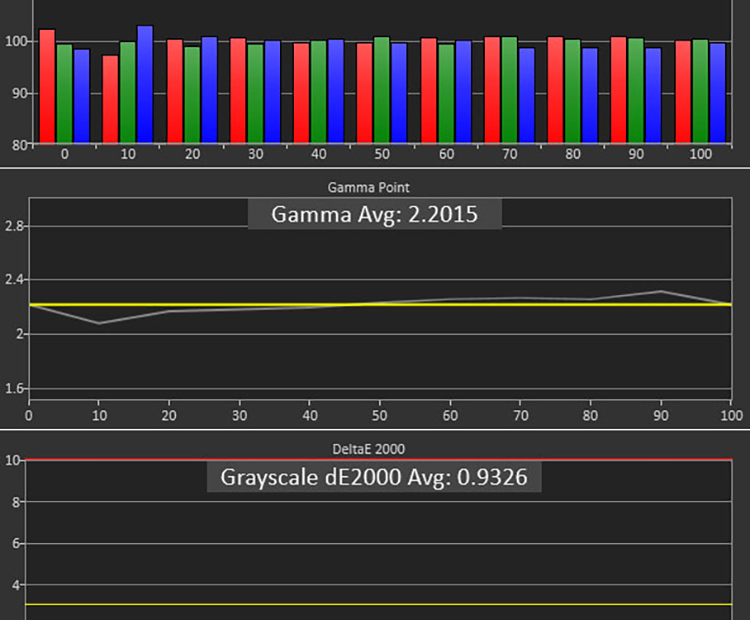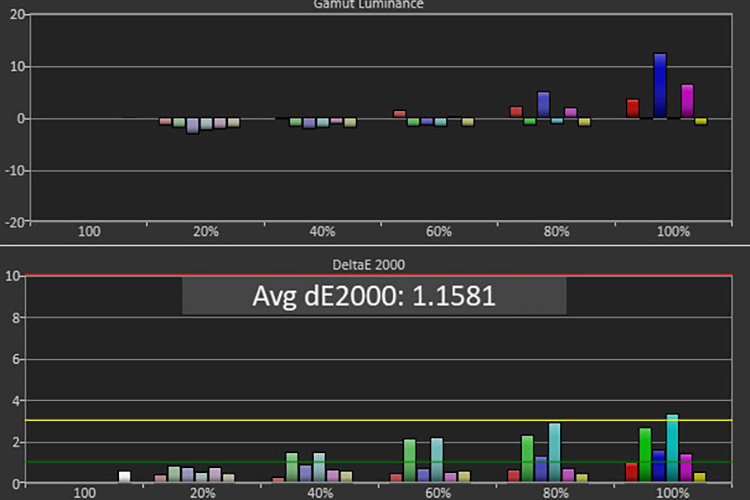The HT2550 4K Ultra HD HDR DLP Projector sells for just $1499 but offers 3840×2160 resolution, HDR10, and 3D in a compact package. You even get built-in audio courtesy of a five-watt speaker. CinematicColor technology delivers accuracy right out of the box with little to no need for calibration as confirmed by my tests. With many Ultra HD projectors costing $10,000 and up, I can’t wait to delve into the HT2550’s secrets.
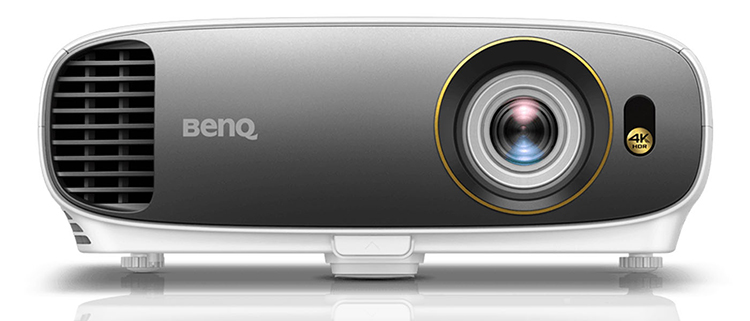
BenQ 4K Ultra HD Projector
- 3840×2160 resolution from a new TI DLP chip
- All-glass lens for superior clarity and uniformity
- HDR10 and 3D support
- Rec.709 color accuracy without calibration
- Compact chassis with built-in 5w speaker
For a short time, a few years ago, Ultra HD was a premium technology, found only in very expensive flat panels and even costlier projectors. That has changed drastically in the past two years to where it’s now almost impossible to buy a TV without it. Advances come a bit more slowly to projectors. Native 4K is still a feature of only a few expensive models. Less expensive examples are making do with pixel shift in order to compete. Is this a bad thing? Not in my opinion. Of all the 4K projectors I’ve reviewed so far, only one, the JVC DLA-RS4500, has been native. All others use some form of pixel shift to simulate higher resolution and the difference is almost undetectable.
BenQ always represents a value choice and offers tremendous performance for the money. It’s only natural then that they be the first to offer an Ultra HD projector for just $1499. Let than sink in for a moment. The HT2550 4K Ultra HD HDR DLP Projector costs less than many flat panel televisions, now that’s impressive. For that diminutive price, you get 3840×2160 resolution from a new .47” DMD chip made by Texas Instruments. It has 1920×1080 pixels but a quad shift produces 8.3 million individually addressable pixels, BenQ calls it True 4K. The 2550 accepts Ultra HD signals up to 60Hz and includes HDR10 support. Color maxes out at Rec.709 but it does a decent job with extended color content. To all this, BenQ adds 3D, one of the very few display manufacturers left that include it. Let’s take a look.
Light engine:
.47” single-chip DLP
Color wheel:
RGBRGB
Native resolution:
3840×2160, 16:9 aspect ratio
Native color gamut:
96% Rec.709
3D:
frame-sequential, top/bottom, side-by-side
Throw ratio:
1.47-1.76
Image size:
30-300”
Lens offset:
110% above lens axis
Lamp:
UHP, 240w
Light output (mfr):
2200 lumens
Video connections:
1 x HDMI 2.0, 1 x HDMI 1.4a
Additional connections:
RS-232, 2 x USB, 3.5mm audio in/out, 12v trigger
Speaker:
1 x 5w
Dimensions:
13.9” x 5.3” x 10.7” (WxHxD)
Weight:
9.2lbs
Warranty:
Three years
MSRP:
$1499
Company:
SECRETS Tags:
benq ht2550, ultra hd, dlp projector, 3d projector, 4k projector, benq, cinehome, Projector Review 2018
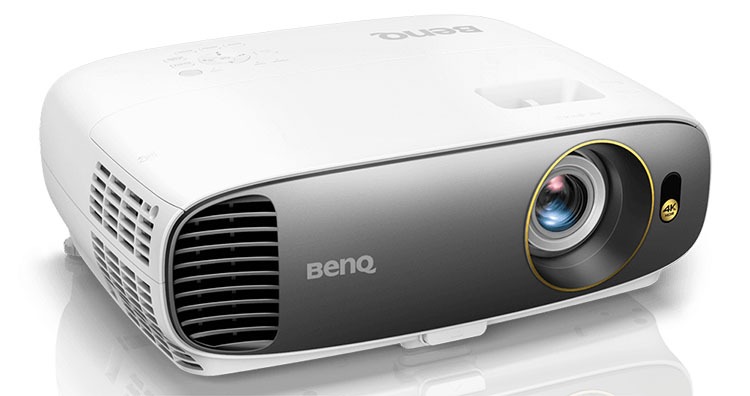
The HT2550 is based on an all-new .47” DMD chip from Texas Instruments. Its native pixel count is 1920×1080 but it shifts four times per frame to create a true 3840×2160 image. While the actual dots are larger than a native Ultra HD design, this approach offers a significantly better pixel fill rate than displays that only shift twice like the JVC LCoS models. It also dispenses with the refraction module used in the light path of JVC and Epson displays, relegating its pixel shift action onto the chip itself. One less object in the light path = a good thing.
Regardless of input signal, it runs at 3840×2160 all the time with each pixel being addressable to the video processing solution which is quite powerful. The color wheel has six sections in an RGBRGB configuration which reduces the rainbow effect to the point where I can’t see it at all.
Optics are all-glass and of extremely high quality. Displaying mundane test patterns and menu screens showed me excellent clarity in all areas of the screen. There is no distortion or color fringing, even at the edges. Since this is a single-chip design, there are no convergence problems to worry about. Color and brightness uniformity are both superb in every respect.
There is no lens shift here, only a 1.2x zoom ratio. Offset is 110% of screen height which means you’ll need to install the HT2550 slightly above or below the edge of your chosen projection surface. Auto-keystone is available but I recommend getting the projector and screen perfectly parallel to avoid any loss of resolution or image distortion.
The chassis is white except for the front baffle which is a dark gray. It’s adorned with discrete badging announcing its 4K capabilities, that helps it stand out against more mundane displays. The lens is off-center and controlled by two barrel adjusters up top. Zoom and focus are the only controls and they move with firm precision and quality. To help level the HT2550, there are threaded feet in back and an extendable leg up front.
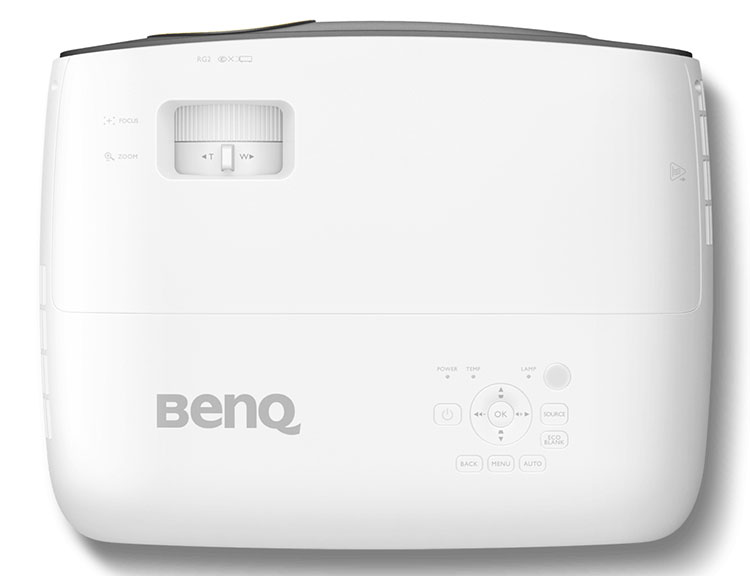
The top of the HT2550 has basic controls for power, menu navigation, and source selection. You also get lamp status lights and an IR sensor. Ventilation is generously provided by grills on both sides and in front. There is a little light leakage from them but nothing that will impact the image.
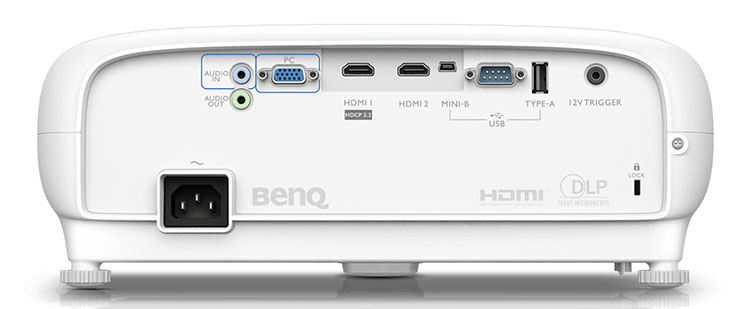
The input panel supports two HDMI sources. One is version 2.0 with HDCP 2.2 and the other is 1.4a. You’ll need to use the first one for Ultra HD sources. It can accept signals up to 3840×2160 at 60Hz. The projector also displays 3D content though you’ll have to manually enable it in the OSD. That cancels the pixel shift feature since the format currently tops out at 1920×1080. Frame pack, top/bottom, and side-by-side content will all work and all that’s required are a pair of DLP-Link glasses. You can get them from BenQ or use a third-party vendor like XPand as I did.

The remote is compact but has just about everything one could need. It’s backlit with a soft orange light that is nice in darkened rooms. Up top are discrete power keys followed by toggles for 3D, lamp mode, picture mode, HDR, and keystone. In the center is menu navigation, then there are transport keys for HDMI-CEC-enabled devices. At the bottom are buttons for various image settings. My only gripe is the absence of discrete input and picture mode controls. Toggling through the different options is a slow process punctuated by long black screens.
With its fixed offset, the HT2550 worked best on a small table in front of my seating. That placed it around 10 feet from the screen. For SDR testing, I connected a single HDMI cable to an Accupel signal generator. HDR benchmarks were performed using an HD Fury Integral in the signal path. For movie-watching, I connected HDMI 1 to an OPPO UDP-203 Ultra HD Blu-ray player. I gave the five-watt built-in speaker a listen and found it clear and reasonably loud with low distortion. It’s bass response is somewhat limited but it is a little better than what you’ll find in most flat panel TVs.
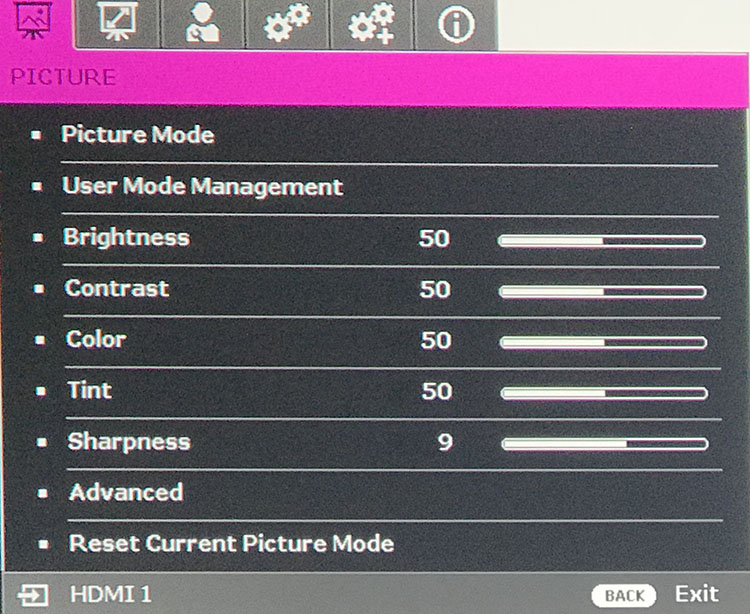
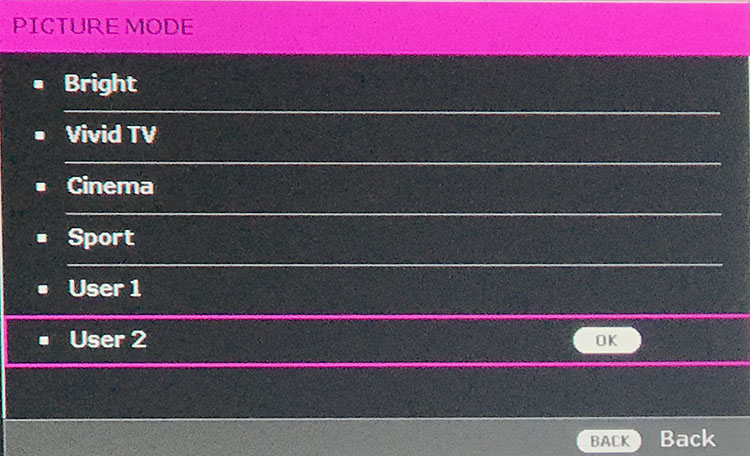
The menu system is just like the one found in other HT-series projectors from BenQ. There are four preset modes plus two user memories and a separate mode for 3D content. Interestingly, there is no specific HDR mode. All the presets are available with HDR content. I employed the two user modes, one for SDR and one for HDR, to keep the settings separate. To play 3D discs, you’ll first need to enable it which in turn shuts off the 4K up-conversion.
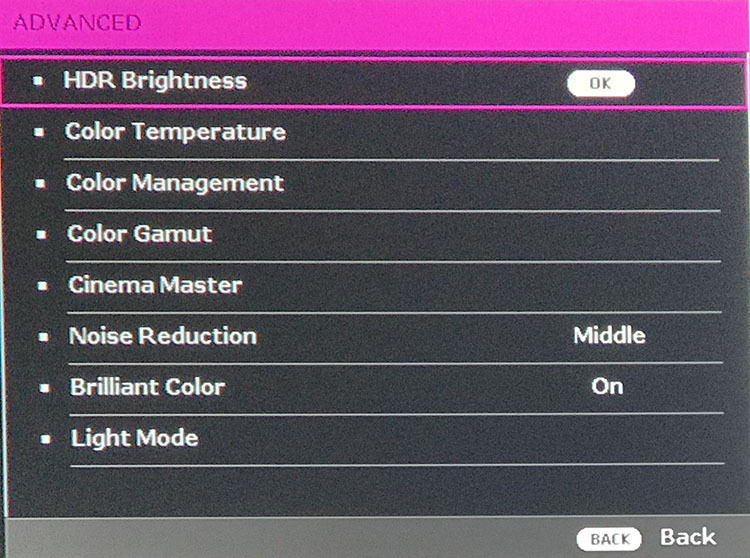
Calibration happens in the Advanced section where you’ll find eight gamma presets ranging from 1.8 to 2.6. I appreciate this fine control and found 2.3 to deliver the most accurate luminance. In HDR mode, this menu is replaced by an HDR Brightness option which offers seven different levels. While it’s tempting to raise output to maximum here, settings above zero cause visible clipping. The most neutral presentation is found at the default.

Two-point grayscale adjustments are available along with four presets. The SDR default is Normal and requires only minor tweaks to achieve accuracy. Without calibration, the HT2550 tested well enough that I would say it doesn’t require adjustment. If you care to tweak further, there is a full color management system available with hue, saturation, and gain (luminance) sliders for each color.
In HDR mode, the same controls are available except gamma is now called HDR Brightness. Cool becomes the default color temp and it is decidedly blue. Changing it to Normal makes a huge improvement. Further calibration is a little tricky because the two-point grayscale sliders won’t bring the entire brightness range in line. Luckily, it’s nearly spot-on so I felt no need to adjust further. You can see all my test results in the benchmark section.
The HT2550, like its HT-series brethren, includes Cinema Master, a set of picture enhancements. Color and flesh tones can be manipulated with the first two sliders. Pixel Enhancer 4K adds some edge enhancement but subtly increases clarity when used sparingly. The final two options improve transitions between contrasting objects without any ringing. It’s fine to leave them both on as their effect is a positive one.
Three lamp modes offer two different brightness levels while the third, SmartEco, throttles the lamp much like a dynamic iris. It works well to improve contrast but it has a slight effect on color and EOTF accuracy in HDR mode. After a little back and forth, I settled on using it for all content, SDR, HDR, and 3D. Finally, if your HDR source doesn’t communicate properly with the HT2550, you can force it into that mode. In my case, Auto worked just fine for both the HD Fury Integral and my OPPO UDP-203.
Ultra HD displays must do it all these days with so much varied content available. It’s likely that good ole 1080p will be the most common format for some time to come. And I don’t plan to toss my hundreds of Blu-ray discs out for Ultra HD replacements any time soon. The HT2550 runs in 3840×2160 resolution all the time so whether you feed it an Ultra HD signal from your player, or hook up a 1080p source, the signal is upconverted. The only exception to this is 3D where you’ll have to disable the 4K mode to see that format.
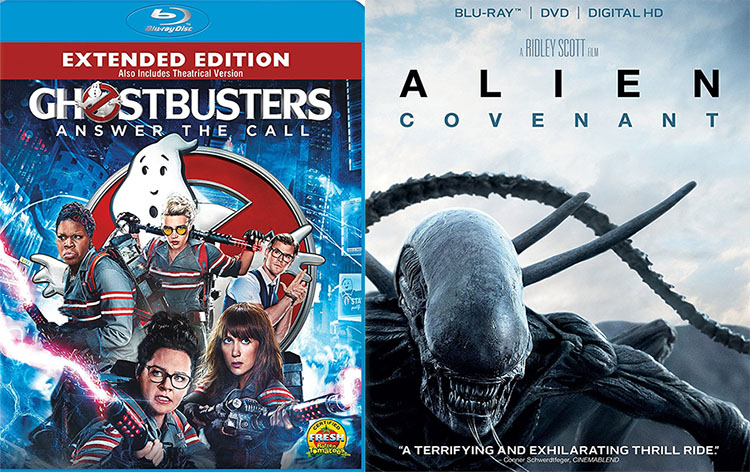
My first impression upon loading Ghostbusters (2016) was the amazing clarity. Any doubts about the quality of pixel shift versus native 4K went right out the window. The HT2550 can easily match resolution with the best high-end Ultra HD projectors I’ve seen like the JVC DLA-RS4500 and Sony’s line of LCoS models, and when the fast-moving action starts, the BenQ’s DLP chip beats them both with a complete lack of motion blur. The film’s over-the-top color was fully present as well with rich primary hues loaded with detail and depth. My only wish was for better black levels as dimly-lit material looked a bit gray. It retained full resolution and never looked murky though. Even heaping doses of film grain could not spoil an excellent image.
Alien Covenant is a great test of black levels with its starfields and dark spaceship interiors. While space looked more gray than black, I had no trouble picking out the finest shadow detail. The clarity of this projector easily outweighs its lack of the deepest blacks. And once a few highlights appear, like glowing instrument panels or the glint of light from metal, DLP’s superior intra-image contrast becomes obvious.
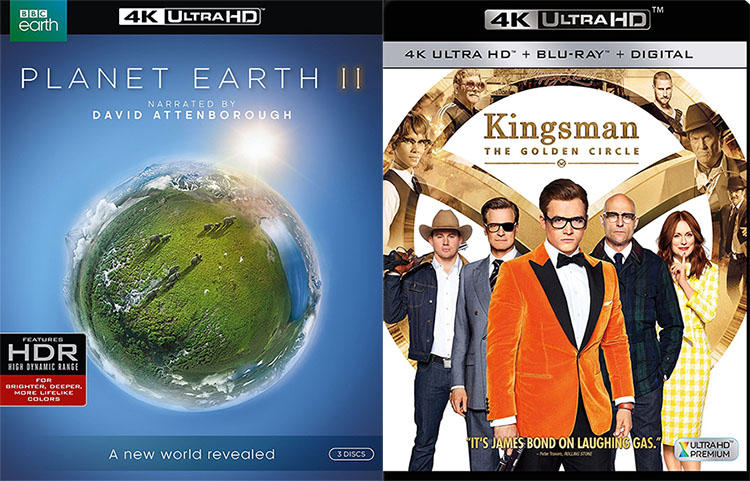
During my trips to trade events like CEDIA Expo, projector makers always show high-quality content shot on state-of-the-art cameras with lots of slow motion. I’ve been told this footage rents for thousands of dollars a minute. Now that Planet Earth II is available on Ultra HD Blu-ray, I suspect we’ll be seeing that amazing material instead. It is simply the best quality video I’ve ever seen. The HT2550 renders every particle, every hair, and every texture, in meticulously-fine detail. The HT2550 handled the material beautifully. Darker scenes, like those in the Cities episode look a bit gray but specular highlights and an almost complete lack of grain makes these images pop. And color looks rich and saturated despite the projector’s Rec.709 limit.
In Kingsman: The Golden Circle, I looked forward to seeing the interior of Poppy’s diner which is dressed in an almost impossible shade of red. Here, it seemed tad less vibrant that what I saw on a DCI-P3-capable monitor. But again, mid to bright-toned content just leaps from the screen. And action scenes retain more depth thanks to their superbly-smooth and blur-free motion. Even the fastest CGI couldn’t ruffle the HT2550’s lightning-fast DLP chip.
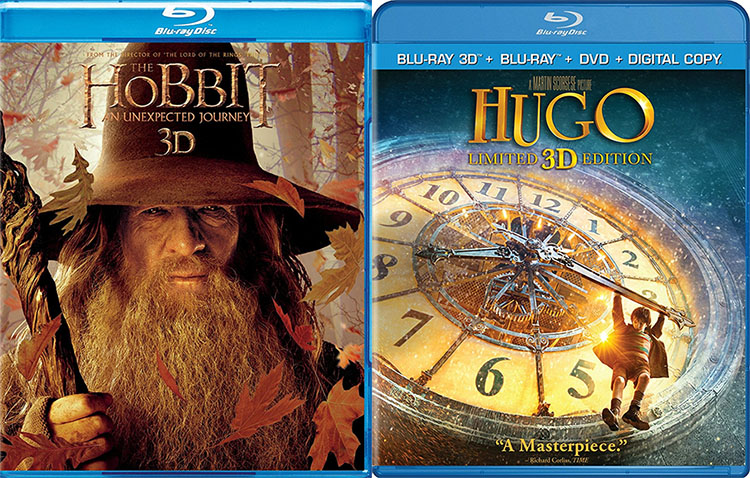
To watch 3D, you’ll have to visit the OSD and turn the feature on which in turn disables the 4K up-conversion. If you don’t, your player may report its inability to find a 3D-capable display. This is a simple task that involves a couple of key presses on the remote. Once enabled, 3D movies look nice and bright with good color. And if you wish, you can calibrate the 3D picture mode separately from the other presets.
Secrets Sponsor
The Hobbit: An Unexpected Journey is a great 3D presentation with lots of visceral textures and good use of depth without a lot of excessive effects. The HT2550 displays a nice deep stage with objects that always look naturally-placed. I saw no crosstalk and dark material never smeared or became undefined. There is plenty of light available here.
Dark scene detail also abounded in my copy of Hugo. I always go straight to the steam tunnel scene to see how three-dimensional those black pipes are. I felt as if I’d burn my hand if I touched them, they looked so realistic. Even though I was watching 1080p, I could clearly see fine surface textures on both metal and stone. Black backgrounds are never quite black but I didn’t find that to detract from the experience.
To test the HT2550’s color accuracy in SDR mode, I measured from the lens with an X-Rite i1 Pro Spectrophotometer fitted with a diffuser attachment. Luminance readings were taken with a Spectracal C6 tri-stimulus colorimeter facing a 92” diagonal Stewart Filmscreen Luminesse with Studiotek 130 material, gain 1.3, at a 10-foot distance. Patterns were generated by an Accupel DVG-5000 and controlled with CalMAN, version 5.8.
I usually find BenQ’s HT-series projectors to perform best in the Cinema preset. It needs little to no adjustment for excellent accuracy and picture quality. I set up the User 1 memory with Cinema as the starting point.
Grayscale tracking runs a tiny bit green in the brighter steps but the error is impossible to see in real-world content. Gamma also tracks on the lighter side though again, it’s not something that can be seen with the naked eye. I took these measurements with the bulb in its Economic mode. This is a good output level for light-controlled rooms and it provides consistent luminance with accurate color saturation tracking. For greater contrast, use the SmarEco mode as I did during the viewing tests.
I made a few changes to the RGB gain and offset sliders to get grayscale well under the 2dE mark at all output levels. With an average of just .93dE, the HT2550 is capable of reference-level performance. Gamma is a little flatter now and I raised the preset to 2.3 for a slightly deeper presentation. That helped the image pop and improved color saturation at the same time. This is excellent performance.
Color gamut tests reveal that there is no real need for calibration. The primary colors are all a tiny bit undersaturated but I couldn’t see any evidence of this when viewing test patterns or watching actual content. Luminance levels are a bit elevated for blue but that doesn’t affect the final error values which are all beneath the visible threshold. I’m glad to see a full color management system in the HT2550 but in Cinema mode, you won’t need to use it.
Grayscale calibration and gamma adjustment bring the average error down to an impressive 1.16dE. This is as good or better than the best projectors I’ve reviewed, some of which cost a whole lot more than the HT2550. Luminance levels are now better balanced and the primary colors are right on their saturation targets. When a dot is in contact with the square on the CIE chart, that indicates an error of 1dE before luminance is factored in. It doesn’t get much better than this for SDR performance in Rec.709.
To simulate an HDR10 signal, I introduced an HD Fury Integral into the signal path. This device sends the proper color and EOTF information when the source is SDR like my Accupel. I used the latest version of CalMAN’s HDR10 workflow to make the measurements and adjustments.

The same picture modes are available in HDR mode as in SDR. I chose Cinema once again as the best starting point. The default color temp is Cool and the chart bears that out. Beyond 20%, whites are visibly blue and the error rises up to and past the clipping point at 65%. You can see the EOTF tracks reasonably well except for a little aberration at 45%. That’s caused by the SmartEco bulb mode which throttles light like an auto iris to help improve contrast. At this point, I will switch to Normal mode before making changes. This is a decent chart for the HT2550’s uncalibrated state but a warmer default color temp would be an improvement.
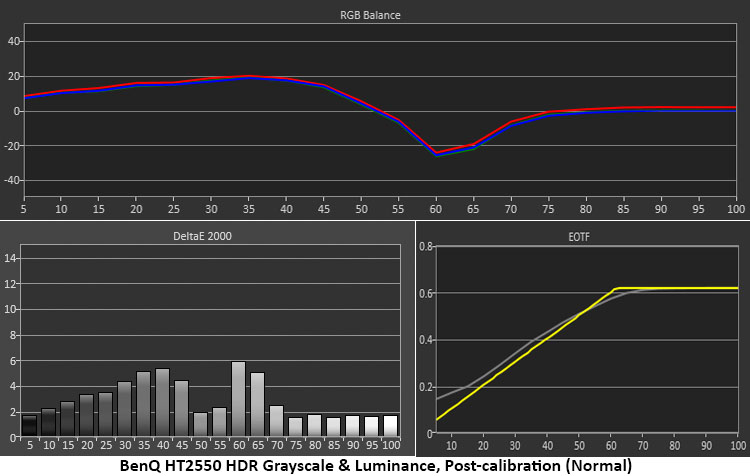
Switching the color temp to Warm takes care of the grayscale tracking issue. There are a few barely visible red errors but adjustments to the RGB sliders can only correct at the 60 and 30% levels. The other steps are left unchanged. I thought it best to leave the controls alone for a more linear result. Picture quality is noticeably better using this approach. Without SmartEco, EOTF tracking is within a whisker of perfect.
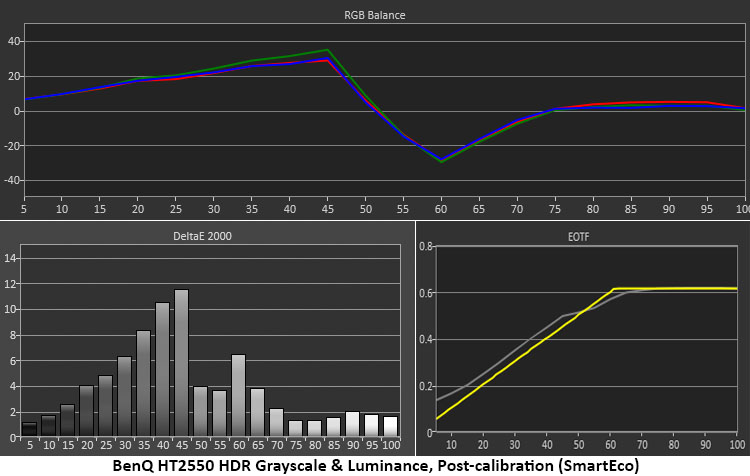
Here’s an example of SmartEco’s effect. Changes in bulb brightness produce visible green errors between 20 and 45% and that aberration has returned to the EOTF chart. These are minor issues and ultimately, I felt the image looked superior. You’ll have to decide for yourself which is better. I think most users will choose a pretty picture over a pretty chart.
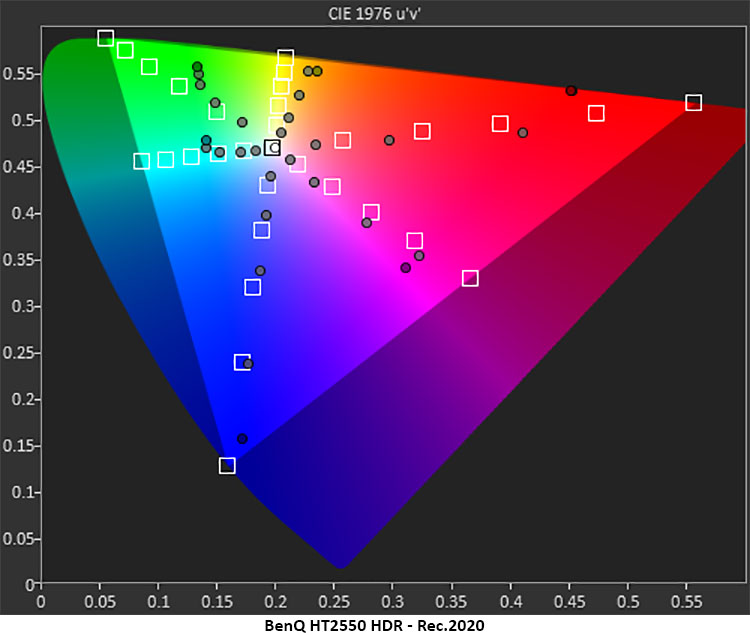
Correct color-handling is key to the Ultra HD and HDR experience. The HT2550 is a native Rec.709 display but most UHD material is encoded in either DCI-P3 or Rec.2020 gamuts. The projector does its best to simulate extended color by making hue adjustments as the saturation points move outwards. In Rec.2020 mode, some points are under-saturated at first to keep things linear. Since I don’t have any actual Rec.2020 source material, I can’t comment on its effect on picture quality. The above chart looks like those I’ve recorded from other HDR displays.

DCI-P3 is a little more realistic for the HT2550’s capabilities. Most Ultra HD Blu-rays and streamed content is mastered in this gamut. Blue tracks well but the other colors come up a little short. Some clipping is evident in red and magenta as the 80 and 100% saturations measure the same. This translates to decent image quality but it’s not quite as rich as what one would see on a DCI-native display.
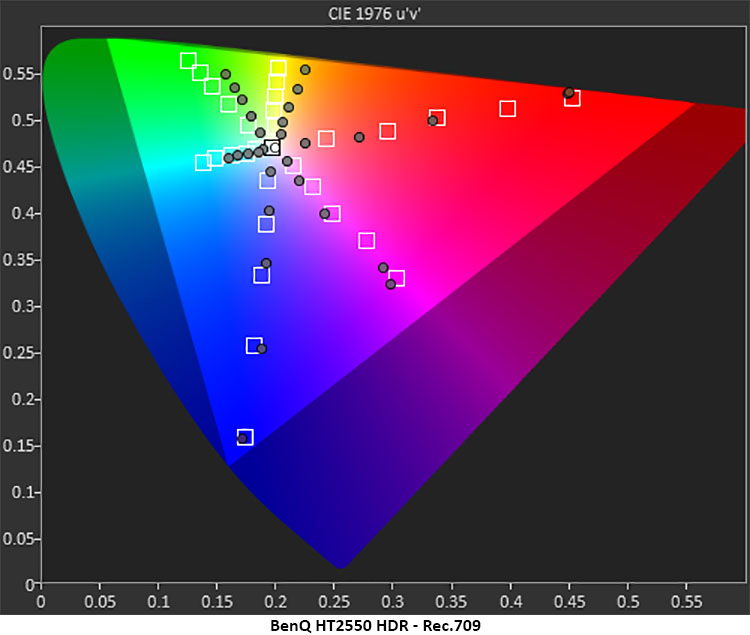
In HDR mode, the HT2550 under-saturates the green primary and cyan secondary for Rec.709 content. The other colors track pretty well though there is some clipping in red. Hue targets are met as all six colors follow their lines correctly except for yellow which looks slightly orange.

The HT2550 exhibits superb video processing for non-UHD content. I set the OPPO UDP-203 to source direct and allowed the projector to handle de-interlacing and scaling chores. It upconverts all incoming signals to 3840×2160. Aside from the 2:2 test which almost no display can pass, there are no issues here. This is important because we’ll be watching a lot of HD material on our shiny new Ultra HD displays for some time to come. Scaling is the easy part, dealing with the film and video cadences from DVDs and Blu-rays requires more effort. BenQ has clearly made that a priority.
Secrets Sponsor
This review marks the first time I’ll be quoting output levels in nits (AKA cd/m2, or candelas per square meter) rather than footLamberts. With HDR becoming more common, it’s just easier to use the metric system. For those needing a frame of reference, 1 nit equals .29fL.
BenQ always provides high output in all its compact DLP models and the HT2550 is no exception. After calibration of the Cinema mode in SDR with the bulb on Economic, I recorded 128 nits peak, .31 nits black, and a contrast ratio of 411.4:1. Switching to Normal ups output to 184 nits with .47 nits black, and 391.7:1 contrast. Engaging SmartEco results in 188 nits peak, .21 nits black and 906.3:1 contrast.
Maximum output is found in the Bright mode which features a very green color temp and clipping of highlight and shadow detail. There, you’ll see 361 nits peak, .12 nits black, and a contrast ratio of 3007.4:1.
For 3D fans, the HT2550 provides good light and a solid presentation with a low crosstalk score of .14%. Output is 25 nits peak, .08 nits black, and 312.7:1 contrast.
HDR output with the bulb on SmartEco is 265 nits peak, .22 nits black, and 1224.7:1 contrast.
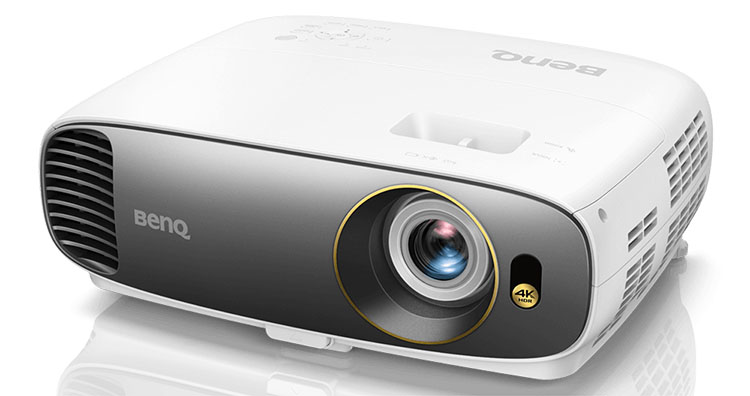
The BenQ HT2550 Ultra HD DLP Projector has no equals at its chosen price point. For $1499 you get Ultra HD, HDR, and fantastic picture quality in a compact package.
- Image quality rivals any 4K projector costing much more
- Lots of output with superb optics
- Accurate color without calibration
- Flexible adjustment options
- HDR10 and 3D support
- DCI-P3 color
- Better black levels
- Faster switching between picture modes and signal formats
At $1499, no one would expect the BenQ HT2550 to match performance with native 4K models costing significantly more. But in many areas, it is their equal. Clarity is the top feature here with sharp and detailed images from both standard and Ultra HD Blu-ray. And in the latter format, HDR makes a subtly positive impact taking the projector to a higher level of quality.
I had some trepidation about the Rec.709 color gamut limitation but once my viewing sessions were complete, I concluded that it was not a deal-breaker. Ultra HD content looked great on the HT2550 and the only way to get that extra bit of color saturation is to spend a whole lot more money.
One should remember the price point here. $1499 is less than the cost of many high-performance displays, of any type. For that sum, you’re getting one of the sharpest pictures I’ve seen from any projector, superb motion processing, accurate color without calibration, and the ability to handle any signal format. 3D may be less popular than it once was but fans will certainly enjoy it on this display. That makes the BenQ HT2550 4K Ultra HD HDR DLP Projector a winner in my book. Unless you have a large budget, there’s no better way to enjoy your movie collection. Highly Recommended.


